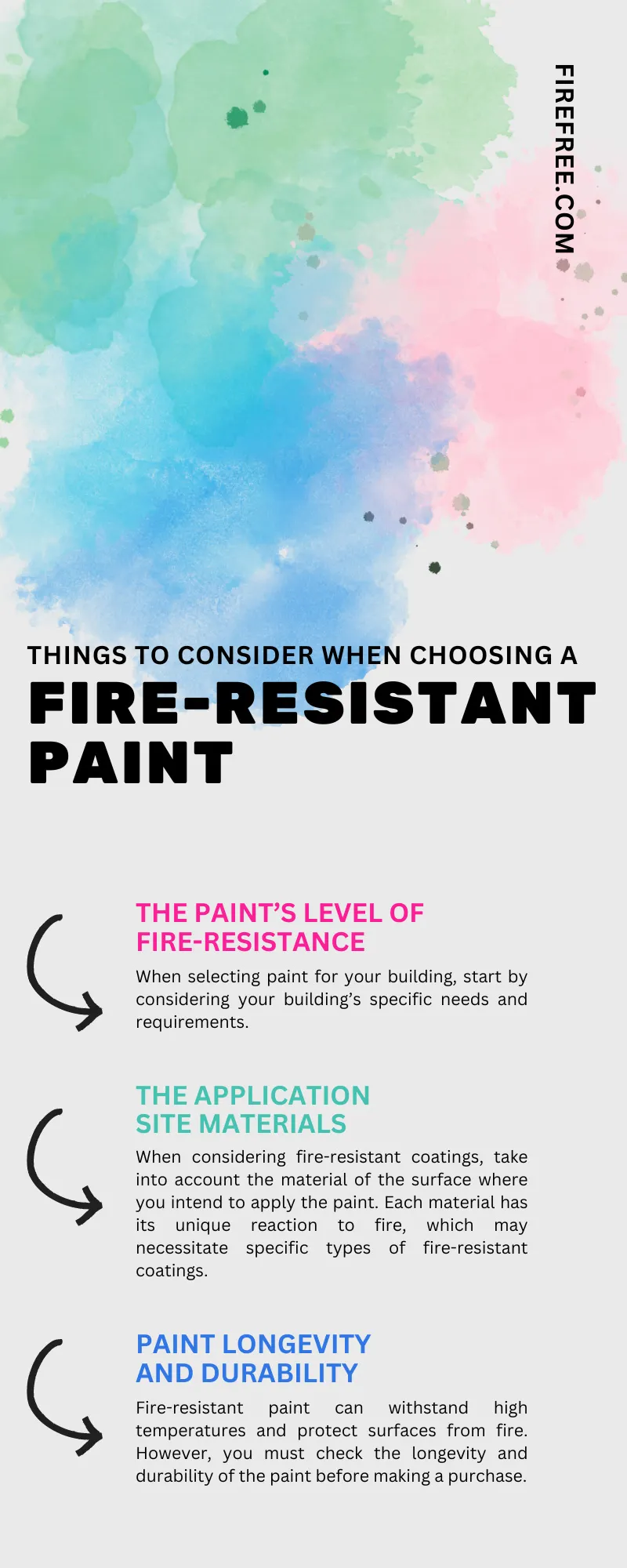Fire-resistant paint is a crucial safety feature for any residential or commercial building. However, before making a purchase, there are several factors you should know to ensure you achieve the maximum protection and best results. Keep reading to explore these important things to consider when choosing a fire-resistant paint for your residential or commercial building project.
Understanding Fire-Resistant Paint
Fire-resistant paint is a special type of coating that incorporates scientifically formulated compounds to slow the spread of fire on various surfaces. Creating a protective barrier mitigates the risk of rapid fire propagation, providing valuable time for safe evacuation and enabling firefighting personnel to combat the flames more effectively.
This innovative solution is a crucial element in fire safety, offering an additional layer of protection and peace of mind in critical situations. Fire-resistant paint is starting to become a standard in many areas of building code, so understand which paint to choose for your respective building project.
The Paint’s Level of Fire-Resistance
Fire-resistant paints fall into several different categories of effectiveness based on rigorous testing and evaluation from professional facilities. When selecting paint for your building, start by considering your building’s specific needs and requirements. Consider factors such as the building’s occupancy, fire hazards, and fire protection systems to choose a paint with a suitable level of resistance.
Fire-resistance ratings are typically expressed by how long the paint can resist fire before breakdown, providing valuable time for evacuation and firefighting efforts. For example, the main three fire rating classifications include Class A paints, Class B paints, and Class C paints, ranging from highest to lowest fire resistance.
The Application Site Materials
When considering fire-resistant coatings, take into account the material of the surface where you intend to apply the paint. Each material has its unique reaction to fire, which may necessitate specific types of fire-resistant coatings. Understanding the characteristics and behavior of different materials can determine the most suitable coating solution for ensuring optimal fire protection.
Different Types of Paints for Unique Materials
Wood
Wood is a commonly used material in both residential and commercial buildings and is highly combustible. Intumescent paints, which expand when exposed to heat, are an excellent choice for fireproofing wood surfaces. The swollen paint creates a protective barrier that slows down the burning process. If you’re working with a wooden surface, consider this as a non-combustible paint for wood.
Steel
Despite being a non-combustible material, steel can weaken and warp when exposed to high temperatures. To protect steel structures, you should use fireproofing paint for steel, also known as intumescent paint for steel. This paint swells up and forms a protective char, insulating the steel from the heat of a fire.
Concrete
While inherently fire-resistant, concrete can still benefit from additional protection. Fireproof masonry paint is ideal for concrete surfaces to provide this extra layer of security.
Drywall
You can fireproof drywall, a common material in interior walls, with fire-resistant latex paints. These paints provide a resistant coating that slows down fire spread.
Each type of fire-resistant paint offers unique benefits that match the characteristics of specific materials. Understanding your specific requirements and the nature of the materials at your site can help you make the most suitable choice for maximum fire protection.
Paint Longevity and Durability
Fire-resistant paint can withstand high temperatures and protect surfaces from fire. However, you must check the longevity and durability of the paint before making a purchase. Some paints may have shorter lifespans or require frequent reapplication, which can be inconvenient and costly in the long run. Choose a paint that offers both effective fire protection and long-term durability to ensure the best value for your investment.
Additionally, if you need to protect a building from the exterior side, make sure to consider a fire-resistant paint that can withstand the elements. Certain types of intumescent paints have special formulations that make them ideal for exterior use.
Paint Aesthetics and Applicability
Fire-resistant paints are available in a wide range of colors and finishes, offering a perfect blend of safety and aesthetics for your building. This paint ensures the integrity of your structure without compromising on your intended style and design. Moreover, certain paints are suitable for both indoor and outdoor use, which makes them a safe choice to protect various areas of the building, from walls to doors and beyond. Embrace the peace of mind that comes with protecting your property without compromising on its visual and curb appeal.
The Paint’s Environmental Impact
A factor you may initially overlook when choosing fire-resistant paint is its environmental impact. You need to choose a paint that’s low in volatile organic compounds (VOCs) since these substances can contribute to air pollution and may cause health issues with long-term exposure. Moreover, consider the sustainability of the paint manufacturing process.
Some companies are taking steps to reduce their environmental footprint by using renewable materials, minimizing waste production, and implementing energy-efficient practices. Opting for environmentally friendly paint contributes to a healthier planet and can enhance your building’s sustainability credentials.
Read More: How Long Does Fire-Resistant Paint Last?
Practices for Applying Fire-Resistant Paint
Implementing proper application practices for fire-resistant paint is essential to secure the expected level of protection. Professionals often recommend multiple coats for proper fire resistance. Keep this in mind to properly gauge the amount of paint you’ll need. Always refer to the paint manufacturer’s instructions for specific application guidelines, including optimal drying conditions and time between coats.
Remember that safety comes first during the application process; wear appropriate personal protective equipment and ensure adequate ventilation to minimize exposure to paint fumes. Only painting professionals should apply fire-resistant materials to ensure their effectiveness and compliance with building codes. If you don’t have a professional painter on site for your project, you can also consider shipping pre-painted construction materials.
Choosing the right fire-resistant paint involves carefully considering several factors. These include the level of resistance, application site materials, paint types, durability and longevity, aesthetics and applicability, environmental impact, and proper application practices. By keeping these considerations in mind and following recommended safety measures during application, you can ensure maximum protection for your building and its occupants in case of a fire.
Be sure to thoroughly research and consult with professionals before making your paint choice to ensure the best results for your specific needs. If you have any additional questions or need help selecting an intumescent paint for your project, browse our website or contact our team at Firefree Inc. today.



